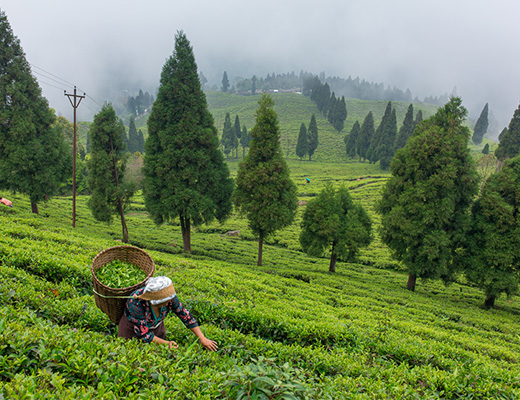Sikkim
Sikkim is home to around 5,000 species of flowering plants, 515 rare orchids, 60 primula species and 36 rhododendron species.


Introduction

Sikkim is surrounded by vast stretches of Tibetan Plateaus in the north, the Chumbi Valley of Tibet and the Kingdom of Bhutan in the east, the Kingdom of Nepal in the west and the Darjeeling district of West Bengal in the south.
The state is richly endowed with rare and exotic flora and fauna, which includes 5,000 species of flowering plants, 515 rare orchids, 60 primula species and 36 rhododendron species. This makes it one of the leading states in the Northeast region in terms of production and supply of cut flowers to mainland consumer markets. Of the 6,000 medicinal plants in India, over 424 plants (including the famous Artemisia vulgaris that is used as an antiseptic) are grown in Sikkim.
Sikkim has several snow-capped peaks including Kanchenjunga, the world's third-highest peak, that attracts many tourists from across the globe. Tourism in Sikkim has emerged as the new profession of the Sikkimese people with its vast natural potential. Promotion of village tourism, homestay, cultural tourism, trekking tourism, ecotourism, wellness tourism, flora tourism and adventure tourism has given a fillip to the tourism trade in the state.
At current prices, Sikkim’s Gross State Domestic Product (GSDP) is estimated at Rs. 0.57 trillion (US$ 9.10 billion) in FY26. GSDP is estimated to expand at a CAGR of 9.10% between FY19 and FY26.
Total merchandise exports from Sikkim stood at Rs. 147 crore (US$ 17.24 million) in FY25 (Until Feb).
Drug formulations, Cereal Preparations and Miscellaneous Processed Item, Engineering Goods and Organic and Inorganic Chemicals accounted for a majority share in the overall exports from the state.
In the state Budget FY26, the government allocated funds worth Rs. 331 crore (US$ 38.7 million) for Urban development.
In 2022-23, the secondary sector contributed 62.60% to the state’s GSVA at current prices. It was followed by the tertiary sector at 28.58% and the primary sector at 8.83%. At a CAGR of 12.66%, the primary sector witnessed the fastest growth among the three sectors between 2011-12 and 2022-23.
As of March 2025, Sikkim had a total installed power generation capacity of 782.48 MW, of which 150.81 MW was under central utilities, 415.11 MW was under state utilities and 216.56 MW was under the private sector. Of the total installed power generation capacity, 76.54 MW was contributed by thermal and 62.67 MW by renewable energy.
Sikkim has a suitable climate for agricultural and horticultural products. It supports multiple crops; viz., rice, wheat, maize, millet, barley, urad, pea, soya bean, mustard and large cardamom. Sikkim is the top producer of large cardamom, contributing over 80% to India’s total production. In August 2019, Sikkim was declared as the world’s first 100% organic state by UN Food and Agriculture (FAO).
The government of India introduced the Northeast Industrial Development Scheme 2017, under which, all new industrial units located in eight northeast states in the manufacturing and services sector of the state were eligible for various incentives.
Key Sectors
Under state budget FY26:
- Rs. 1,063 crore (US$ 124.4 million) for development of Roads and Bridges.
- Rs. 331 crore (US$ 38.7 million) for Urban development.
- Rs. 2,256 crore (US$ 264.1 million) for Education, Sports, Arts, and Culture.
- Rs. 778 crore (US$ 91.1 million) for Health and Family Welfare.
- Rs. 1,094 crore (US$ 128.1 million) for Agriculture and Allied Activities.
FACTFILE
Capital
GangtokGeographical Area (sq km)
7,096State Language
Nepali, Bhutia, Lepcha, Limboo, Magar, Rai, Hindi and EnglishLiteracy Rate
81.42 per centKey Industries:
Tourism
Agriculture
Floriculture
Agro-processing
Hydroelectric power
Tea





